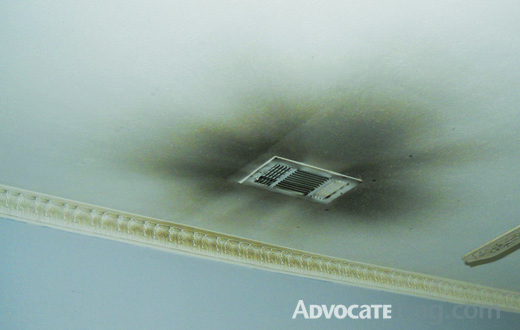Some older East Dallas homes may be equipped with a ‘ticking time bomb’

A faulty electric panel made by Federal Pacific Electric, a company that is no longer in business, sparked a fire that caused about $190,000 worth of damage to a White Rock area home. The homeowners, in this case, escaped unharmed.
On a spring evening in 2010, a White Rock area couple had just settled in for a quiet evening at home when they heard a loud pop and the lights went out. In the garage, they saw flames shooting out of a breaker box.
“The fire extinguisher did nothing to help,” homeowner Karen Clardy says.
She had time to grab her purse and her dog and run to the lawn before her home was engulfed in flames.
“I just thought, ‘This isn’t happening.’ I’ve imagined before what I might try to save if my house ever caught fire. In reality, I didn’t have time for any of it,” she says.
Six fire trucks arrived within five minutes, but by then the house had suffered $190,000 worth of damage and would be unlivable for the next five months.
The source of the fire, according to Dallas Fire-Rescue reports, was the electrical panel, a Federal Pacific Electric Stab-Lok.
The Clardy fire quickly became the jumping-off point for discussion, followed by both a Dallas Morning News story and a NBC5 report about the Federal Pacific brand, which is a type of circuit breaker used in many homes built in our neighborhood in the 1960s, ’70s and ’80s.
The panels are considered unsafe. A breaker, when overloaded, is supposed to automatically flip off, says Gus Antos, co-owner of Milestone electric company, but the FPE panels don’t always automatically turn off or “trip”. There has been at least one class action lawsuit (in New Jersey) against Federal Pacific Electric, and the company is no longer in business.

Replacing an electric panel can cost about $2,000, but those who have lost a home to fire say it’s better to pay now than later.
Clardy, whose misfortune was cited in both stories, says she doesn’t mind the media attention.
“I am glad people are learning about this,” she says. “If I’d have known that the panel was dangerous, I wouldn’t have thought twice about getting it replaced.”
But it’s not an easy decision for everyone. Replacement can cost as much as $2,500 or more in some cases, Antos says.
“I think of it like putting your seatbelt on. Chances are good that when you get in your car, you are not going to get in an accident, but that doesn’t stop you from buckling up, just in case. The difference is that this is a big expense for some people, and it’s not a sexy purchase.”
Luke Miller of East Dallas put it off for a while, but eventually decided to pay the price in the interest of safety.
“My wife and I just bought a home in Lochwood that contained the dreaded panel. After mixed advice, we decided to go ahead and replace it. We decided that peace of mind was worth the money,” he says. “We found a skilled, and more-importantly, licensed electrician who did the whole job for around $1,200, and we’re really glad we went ahead and did it.”
Homeowner Keith Graham knew about the potential dangers of his FPE panel and wishes he hadn’t waited to replace his. Just after midnight on May 16, 2009, he and his wife, Kathleen, awakened to their “dogs barking like crazy,” and thought someone was breaking in.
Keith jumped into action.
“In the seconds between getting up and reaching the garage, I noticed the lights were out. I wondered, ‘Did they turn off our electricity?’ ”
He opened the garage door to an inferno that had already engulfed the family car. He yelled at his wife to get their son, Jason, and get out. Smoke filled the house. He grabbed his phone, dialed 911 and ran out the front door hollering for his wife, but no answer. He ran back inside.
“I was screaming at the 911 operator, screaming for my wife and son at the same time, and then I heard the fire truck outside and they drove right by my house,” he says. “I ran out the door, chasing the truck, got their attention then ran back toward the house screaming. It was pure chaos.”
At that point, a neighbor told Keith that Kathleen and Jason were inside another neighbor’s home, but Keith was suffering from delirium caused by severe smoke inhalation.
“They found me wandering in a nearby yard. The next thing I remember was waking up in the ambulance with an oxygen mask on my face.”
The next day, the fire investigators told the Grahams that the blaze had begun in the electric panel.
“I knew it was a bad panel,” he says.
The family was preparing to embark on a remodeling project and Keith, who runs an East Dallas-based air conditioning company with his brother, Kelly, had already purchased a replacement. He just hadn’t gotten around to installing it yet.
“I lost everything in that fire, and almost my life,” he says.
These types of electrical fires spread remarkably fast, Graham says, because the panels are often located in the garage, “where you keep lawn mowers and gasoline and all of your most flammable items.”
Many other panels are in closets, also a source of kindle such as clothing and Christmas decorations.
Like Clardy, Keith Graham feels obligated to share his experience with anyone who will listen.
“I’ve had at least 30 panels in the neighborhood replaced because of my story,” he says. “These things are ticking time bombs, and if I saw one in someone’s home, didn’t warn them and something happened to them, I couldn’t live with myself.”
Clardy and Graham’s anecdotal evidence is alarming, but there are no hard statistics when it comes to how many FPE panels cause house fires because fire investigators typically report electricity-caused fires as “electrical malfunction”. It would be rare for an investigator to take note of the brand on the electrical panel, Section Chief James Adams of the Dallas Fire and Rescue Fire Investigation Division says.
Antos, whose company has replaced “hundreds, maybe thousands” of panels in the Dallas area, says that it would be unfair to call FPE-caused fires “common”.
“Statistically, there might have been five fires [in the Dallas area] in the last 10 years,” he says. “I don’t want to scare people, but if there was one in my house, I would get it replaced.”
Antos notes that homeowners who have an FPE panel but can’t replace it can do a few things to make the home safer: Have someone look at the breaker box once a year. Make sure it is working and that the breakers are tight. Every few months, flip the breakers on and off — it may help to unlock the components that prevent it from tripping.
Still, your best bet, Antos says, is to have a qualified electrician replace the panel.
Clardy and Graham agree.
“You can pay now,” Clardy says, “or you might pay later.”
Find more information about panels at ismypanelsafe.com or inspectapedia.com.





